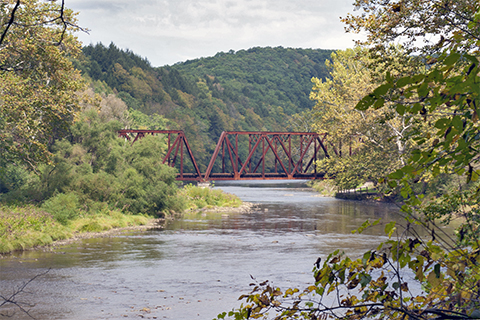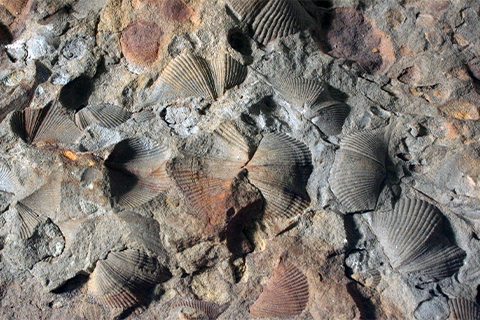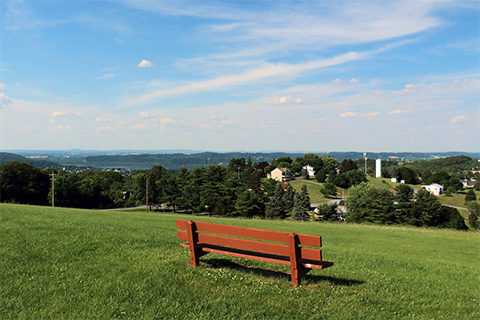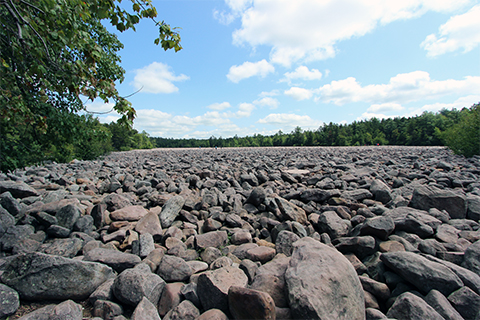Ask any thru-hiker on the Appalachian Trail and they’ll tell you that Pennsylvania has a lot of rocks, making the path through the state a bit challenging. Here in the commonwealth our geology also provides unique experiences and things to see.
Some are unusual features, like potholes and ice mines. Some are good examples of geologic features that are usually hidden beneath the ground.
Others have scenic views that provide a look at the surrounding landscape.
DCNR’s Bureau of Geological Survey is here to help make sense of these rocks. The Trail of Geology was created to guide and connect visitors to the fascinating geology of our parks and forests.
The trail is a series of publications and guides that include explanations, photos, and cross-sections.
If you know what to look for, the geology of Pennsylvania can tell a vast story.
Rocks can teach us about a time of prehistoric mountain building, ancient organisms, and the industries that made Pennsylvania the place it is today.
Using one of these guides is easy. Simply take it with you as you hike or bike the park trails or drive the roads in and around the park.
Here are some examples of the stops along the Pennsylvania Trail of Geology.
Oil Creek State Park -- Ice and Oil Shape the Land

Visitors to Oil Creek State Park in Venango County can learn about the world’s first commercial oil well. The Trail of Geology Guide (PDF) for the park sheds light on the forces at work under the ground.
Oil Creek State Park has an abundance of natural geologic features, such as waterfalls, boulder fields, and glacial deposits.
During the Ice Age, when continental ice sheets covered parts of North America, the glaciers moved southward across northwestern Pennsylvania, including Oil Creek State Park. These incredible mountains of ice left visible impacts on the land, even today.
The guide includes a map to show the locations of many sites of geologic interest.
You will learn to identify the bedrock and surficial deposits of the area, along with the story of how Oil Creek gorge formed.
Swatara State Park -- Geologic Features and Fossil Sites

Along the historic Swatara Creek in Lebanon and Schuylkill counties, Swatara State Park has much to be explored.
The park’s Trail of Geology Guide (PDF) explains the formation of the surrounding mountains and Swatara Gap, one of the most outstanding of Pennsylvania’s water gaps passing through Blue Mountain.
The gap is about a mile across at its widest point and 800 feet in depth.
Visitors can also try their luck finding fossils at the Suedberg Fossil Site. As you examine the eroded hillside, learn about the organisms that created the fossils present in the park.
The trail guide includes illustrated examples of what you could find.
Samuel S. Lewis State Park -- Mt. Pisgah and the Lower Susquehanna Valley

In York county, Samuel S. Lewis State Park is dominated by 885-foot-high Mt. Pisgah.
The view from the top of Mt. Pisgah encompasses several hundred square miles of rolling Piedmont landscape to the north, east, and south.
Complete with photos, the Trail of Geology Guide (PDF) for the park points out 11 points of interest to see from the panoramic view.
This guide explains the view from the top, and the rocks that make up the mountain. A geologic map and cross section of the area help to illustrate the massive, interweaving bedrock.
The trail guide also covers the construction of three hydroelectric dams on the lower Susquehanna River and the history of coal dredging from the sediments of Lake Clarke.
Explore Pennsylvania’s Geology

No matter where you go in Pennsylvania, there is history beneath your feet.
As you explore parks and forests, take the time to learn more about the geology of the area.
This series of guides makes it easy to learn something new and unexpected when you visit a park or forest.
Before you head out to a state park, check the DCNR website to see if there is a Trail of Geology publication for that location.
You can also search for these publications using PaGEODE under “Map Layers."
You can even make a special trip to each site and “thru-hike” the entire Trail of Geology.
Whether you are looking to learn something new about your local park, or explore a whole new area of interest, the Trail of Geology has something for everyone.